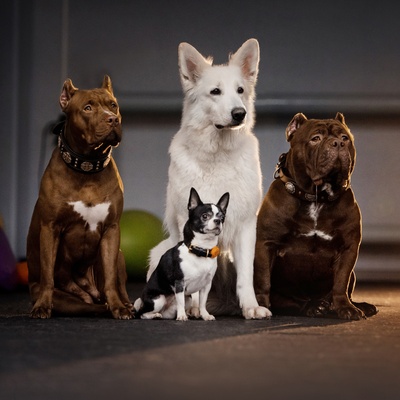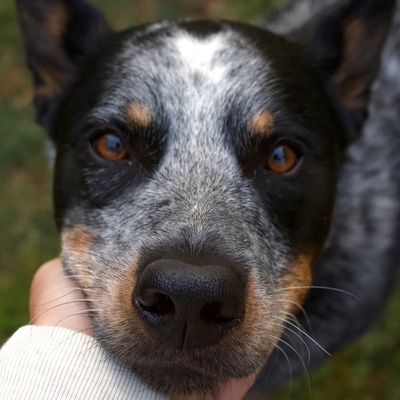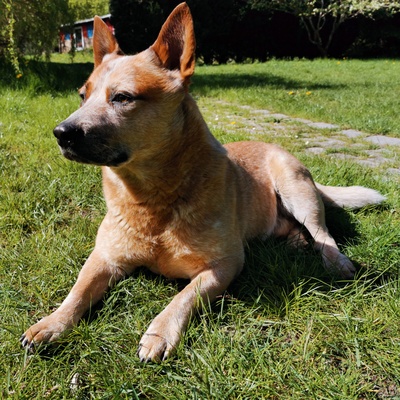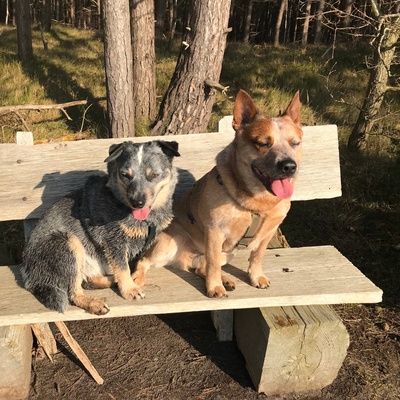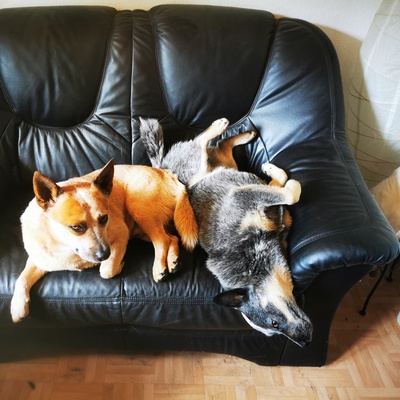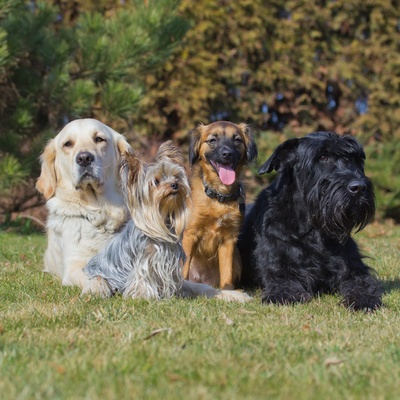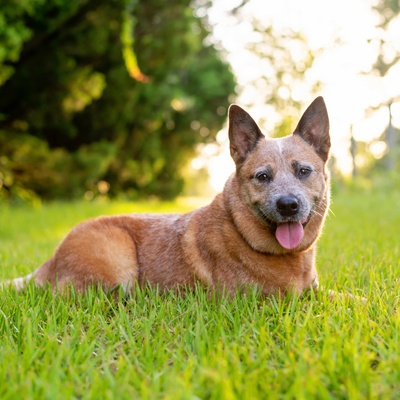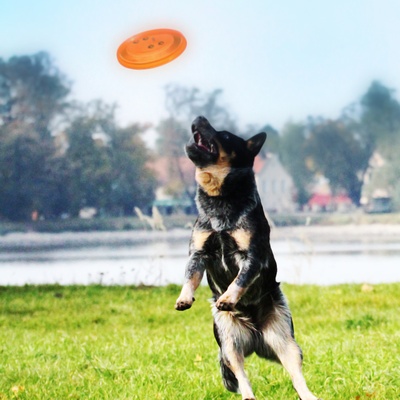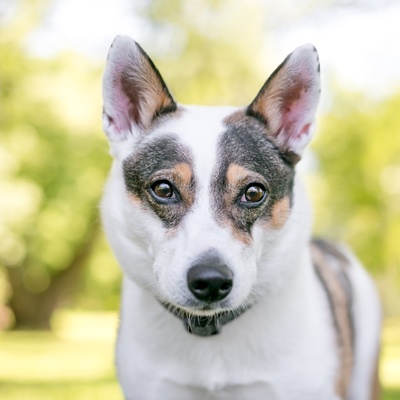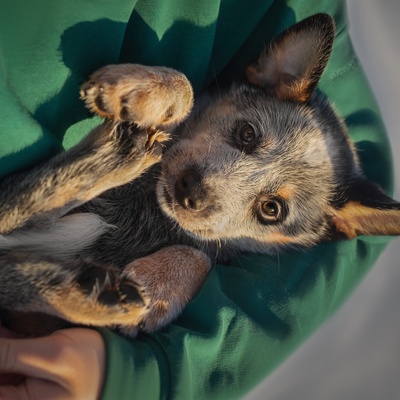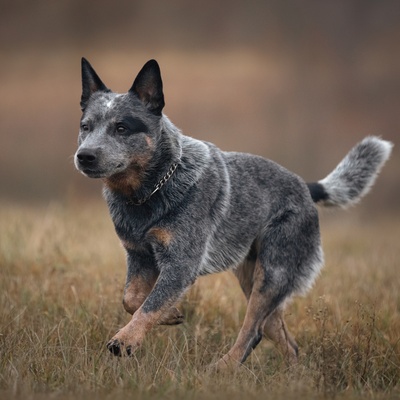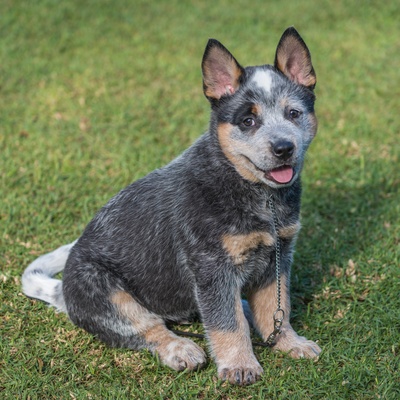Introducing the Australian Cattle Dog
Discover all there is to know about the Australian Cattle Dog : its characteristics, behavior, training, and its cost.
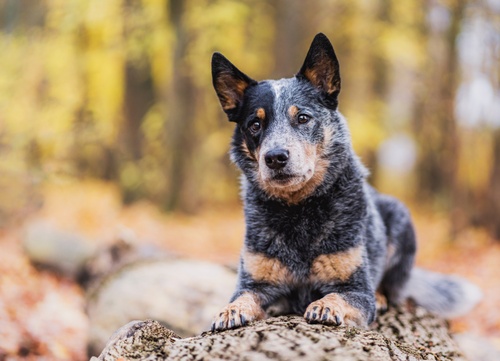
Discover all there is to know about the Australian Cattle Dog : its characteristics, behavior, training, and its cost.
The Australian Cattle Dog, commonly known as the "Blue Heeler" due to its distinctive blue-speckled or red-speckled coat, originates from Australia where they were bred for herding cattle across vast and challenging terrains. Australian Cattle Dogs stand out as one of the most industrious dog breeds worldwide. They are renowned for their intelligence, agility, and capacity to handle a variety of tasks far beyond herding.
Their versatility makes them excellent candidates not just for herding but also for participating in dog sports, serving as watchdogs, and providing companionship. With a nature that is loyal and protective, Australian Cattle Dogs make affectionate companions, albeit with a cautious approach to strangers, showcasing their loyalty to their family unit.
This section outlines the unique features of the Australian Cattle Dog breed.
The Australian Cattle Dog belongs to the herding group (1), which includes breeds known for their ability to control the movement of other animals.
Australian Cattle Dogs are medium-sized breeds. They typically range from 17 to 20 inches in height at the shoulders and weigh between 30 to 50 pounds.
The coat of an Australian Cattle Dog is short to medium in length, providing them with a layer of protection against harsh weather conditions.
Australian Cattle Dogs are primarily known for their distinctive "blue" or "red" speckled coats. The blue variety may have blue, black, or tan markings.
Australian Cattle Dogs are highly adaptable to various living environments but thrive in homes where they can get plenty of physical and mental stimulation.
While Australian Cattle Dogs are loyal and protective of their families, they can be reserved with strangers, making early socialization crucial.
Australian Cattle Dogs are generally robust and healthy, but like many breeds, they can be predisposed to certain genetic conditions like hip dysplasia and progressive retinal atrophy.
Australian Cattle Dogs are intelligent and eager to please, making them relatively easy to train. They respond best to positive reinforcement techniques such as treats and praise.
We can help!
Every dog has its own character, and so do you. Making the right choice will ensure his well-being and yours.
Take our quiz to find out which breed is right for you, based on your personality, lifestyle, location and many other criteria.
Don't wait any longer and take the quiz to find out the answer!
Australian Cattle Dogs are compact, robust, and muscular, designed for agility and endurance. Their coats are striking with a unique pattern; blue or red speckles cover their entire body.
Australian Cattle Dogs are moderately sized but very sturdy. Females typically stand between 17 to 19 inches tall, and males range from 18 to 20 inches. In terms of weight, females weigh around 30 to 45 pounds, while males range from 35 to 50 pounds.
These dogs mature relatively fast, reaching their full size by about one year of age. Their growth is quick and significant during the first six to eight months, slowing down as they approach their first birthday, by which time they generally reach their adult height and weight.
Australian Cattle Dogs boast a double coat, with the outer layer being moderately short, straight, and weather-resistant. This outer coat is denser around the neck, forming a slight ruff, which adds to their rugged appearance. The undercoat is shorter and denser, providing insulation against both the heat and the cold, which is ideal for their origins in the harsh Australian outback.
The coloration of Australian Cattle Dogs is one of their most distinctive features. They come primarily in two color varieties: blue and red. The blue coats can show blue, blue mottled, or blue speckled patterns, possibly with markings in black, blue, or tan. Red dogs are evenly speckled with solid red markings. These unique patterns are crucial to the breed standard and highly valued for their aesthetic.
The coat of an Australian Cattle Dog is relatively easy to maintain due to its length and texture. However, they do shed, particularly during the change of seasons. Regular brushing, about once a week, is sufficient to remove dead hair and maintain the coat’s natural condition. During shedding season, increasing the brushing frequency can help manage the shedding and keep the coat healthy.
Due to their hardy nature, Australian Cattle Dogs require minimal bathing, only when necessary, to protect the natural oils that keep their coat healthy. This breed’s coat does not trap dirt easily, making them relatively clean dogs with a coat that provides practical protection in various weather conditions.
The Australian Cattle Dog is a model of balance and proportion, designed for endurance and agility. The head is broad and slightly curved between the ears, with a slightly tapering muzzle that gives them a determined expression. Their eyes are one of their most expressive features: oval in shape and typically dark brown, they reflect an alert and intelligent demeanor. The ears of the Australian Cattle Dog are wide, medium in size, and positioned upright on the head, enhancing their vigilant appearance.
The overall body structure is robust with a level back and a strong, muscular loin, contributing to their agility and power. This build is essential for a working dog capable of handling both speed and sudden movements, making the Australian Cattle Dog a standout in both appearance and functionality.
The Australian Cattle Dog is renowned for its loyalty, intelligence, and protective nature. This breed exhibits a profound devotion to their family, often forming a strong bond with a single person.
The world of dog breeds is vast, with over 340 recognized dog breeds categorized into 10 groups by various kennel clubs. The Australian Cattle Dog falls into the herding group (1), which is composed of breeds that are historically adept at controlling the movement of other animals. This group includes breeds such as the Border Collie, German Shepherd, and Old English Sheepdog. Dogs within the herding group are celebrated for their exceptional intelligence, trainable nature, and instinctive behavior to herd animals.
Australian Cattle Dogs excel in their primary role as herding dogs but are also capable of performing numerous tasks beyond herding. They are known for their agility, high energy, and endurance, making them suitable for various dog sports and roles including watch dogs and companions in active households.
Australian Cattle Dogs are known for their high energy, intelligence, and loyal nature. They display a deep bond with their owners, often forming a close attachment to one particular person in the household. This breed thrives on interaction and tasks, requiring an owner who is actively involved in providing physical and mental stimulation.
They are not only protective but also show their affection through constant companionship and a readiness to work alongside their human.
Australian Cattle Dogs exhibit a bold and confident nature that makes them natural watchdogs. They are generally wary of strangers but can be sociable once proper introductions are made. Their sociability extends to getting along well with other pets, especially when socialized from a young age. This breed is also known to be good with children, showing patience and protectiveness, although their herding instincts may prompt them to nip at heels gently to herd them.
It is crucial for owners to cultivate their Australian Cattle Dog's sociability early on to nurture their ability to interact well with humans and other animals.
Take the test and find out the dog breed that matches your personality and lifestyle.
Australian Cattle Dogs are remarkably adaptable and can thrive in various living situations. Urban or rural environments can both be suitable if the dog's physical and mental stimulation needs are met. Owners should ensure that they provide ample attention, with daily activities to keep their dog engaged.
The adaptability of Australian Cattle Dogs extends to their need for a stimulating environment where they can explore and expend energy. A secure outdoor space is highly beneficial for this breed, allowing them to satisfy their curiosity and inherent need to be active. While they are versatile in their ability to live in different settings, having access to open, secure areas where they can run and play is ideal for maintaining their physical health and mental sharpness.
Australian Cattle Dogs are renowned for their superior intelligence and remarkable ability to learn quickly, making them highly trainable. Their sharp minds require engaging and varied training methods that focus on positive reinforcement and consistency. Given their working dog heritage, Australian Cattle Dogs respond well to tasks that challenge both their minds and their physical agility.
To safeguard against their tendency to wander or chase, equipping an Australian Cattle Dog with a GPS collar is advisable, ensuring they can be tracked during outdoor activities and preventing potential escapes.
Australian Cattle Dogs possess excellent listening skills, which when harnessed through training, make them responsive and attentive to commands. This breed's unique characteristics include a strong work ethic and a persistent desire to manage their environment, which can sometimes be mistaken for stubbornness. Training should therefore be approached as a way to channel their energy and natural instincts constructively.
Their alertness makes them excellent candidates for activities like agility training, herding trials, and obedience competitions, where they can demonstrate their skills and responsiveness. Focusing on their ability to follow commands and interact cooperatively can turn these intelligent dogs into both valuable working partners and loyal family members.
Australian Cattle Dogs are generally known for their robust health and active lifestyle. Consistent, daily care is crucial to maintain their health, focusing on preventive measures to avoid common diseases and infections.
Australian Cattle Dogs are typically hearty and have good overall health. This breed is, however, prone to certain genetic conditions such as hip dysplasia, progressive retinal atrophy, and deafness. These issues are common in many active breeds and involve joint problems and sight or hearing loss, respectively.
Symptoms can range from mild discomfort to more severe mobility issues or sensory deficits. It's important to monitor their health closely and consult a veterinarian if any unusual signs are observed. The typical lifespan for Australian Cattle Dogs ranges from 12 to 15 years, reflecting their generally healthy constitution.
Regular veterinary care is vital throughout an Australian Cattle Dog's life. It is important to keep up with vaccinations, deworming schedules, and treatments for fleas and ticks as recommended by a veterinarian. Daily care includes routine brushing of their coat to remove debris and shed fur, regular ear cleaning to prevent infections, and dental care including teeth brushing to prevent tartar buildup. Nail trimming should also be part of their grooming routine to prevent overgrowth and splitting, which can be painful and lead to walking difficulties.
Being aware of the dog’s potential allergies is also important; always consult a vet for dietary recommendations or if you suspect your dog has developed an allergy. Australian Cattle Dogs are not hypoallergenic and can shed moderately, which might be a consideration for people with severe allergies.
The Australian Cattle Dog, known for its high energy and agility, requires a balanced diet that fuels its active lifestyle. A diet rich in proteins and vitamins is crucial not only for maintaining muscle mass but also for ensuring overall well-being. To meet these needs, we recommend feeding your Australian Cattle Dog premium quality kibble that is specifically formulated for active breeds. Such kibble ensures that your dog's diet is balanced and complete, providing all the necessary nutrients without the need for extensive meal planning.
For those Australian Cattle Dogs who are especially active, or for those looking to add variety to their diet, supplementing with lean meats such as chicken, turkey, or beef can be beneficial. These meats are excellent sources of additional protein but remember to keep the fat content low to avoid weight gain and ensure optimal health.
Australian Cattle Dogs are highly regarded for their intelligence, agility, and loyalty. It's important to consider several factors before adopting, such as the breeder's reputation, the dog's health, and your lifestyle needs.
Before adopting an Australian Cattle Dog, it is crucial to make an informed decision. Selecting a reputable breeder is vital, as this directly influences the health and well-being of the puppy. It is important to inquire about the health of the puppy and its parents. A responsible breeder will provide transparency regarding the health status of the puppy, including any known illnesses in its lineage. This information is essential for preparing for the future health care of your new pet.
Lastly, you must have your dog microchipped by the age of 8 weeks old and have their details registered on a relevant database like Petlog or Animal Tracker. This is a legal requirement in Great Britain, and non-compliance could result in a
fine. For microchipping, consult your veterinarian. Alternatively, any Blue Cross center will offer this service free of charge.
The acquisition cost of an Australian Cattle Dog can vary based on several factors, including the breeder's reputation, the dog's lineage and pedigree, and the age of the dog. Generally, the price range for an Australian Cattle Dog puppy in the UK can vary significantly but typically falls between
and
.
Owning an Australian Cattle Dog involves ongoing costs that potential owners should consider. These costs include food, veterinary care, training, and accessories. The estimated annual cost of maintaining an Australian Cattle Dog is approximately
to
, depending on various factors like health and lifestyle.
Choosing a dog that matches your personality and lifestyle will ensure your well-being and his!
To access the most relevant information, suitable payment methods, and delivery in your region, please select the website corresponding to your country.

